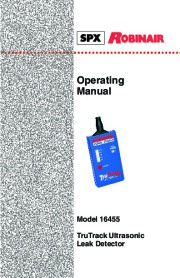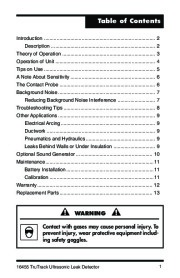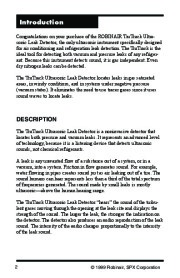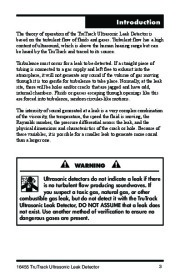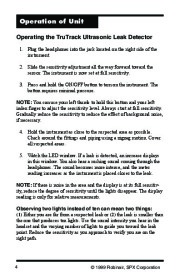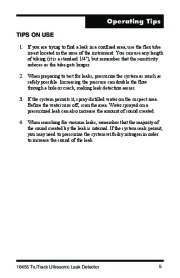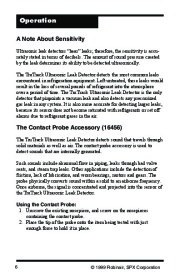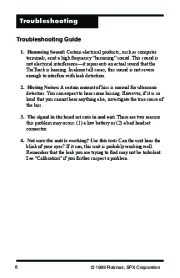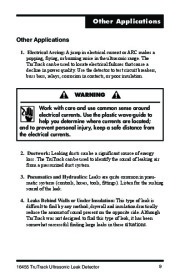| Categories | Power Tool |
|---|---|
| Tags | Robinair 16455 |
| Download File |
|
| Document File Type | |
| Copyright | Attribution Non-commercial |
Operating Manual Model 16455 TruTrack Ultrasonic Leak Detector Table of Contents Introduction 2 Description . 2 Theory of Operation . 3 Operation of Unit 4 Tips on Use 5 A Note About Sensitivity . 6 The Contact Probe . 6 Background Noise 7 Reducing Background Noise Interference . 7 Troubleshooting Tips 8 Other Applications 9 Electrical Arcing 9 Ductwork 9 Pneumatics and Hydraulics 9 Leaks Behind Walls or Under Insulation 9 Optional Sound Generator .
Heating, Ventilating and Air Conditioning User Manual Free Download. HAVC Operator’s Manual. Auto AC Free Instruction Manual Download PDF.
10 Maintenance 11 Battery Installation .11 Calibration .11 Warranty . 12 Replacement Parts . 13 WARNING Contact with gases may cause personal injury. To prevent injury, wear protective equipment including safety goggles. 16455 TruTrack Ultrasonic Leak Detector 1 Introduction Operations Overview Congratulations on your purchase of the ROBINAIR TruTrack Ultrasonic Leak Detector, the only ultrasonic instrument specifically designed for air conditioning and refrigeration leak detection. The TruTrack is the ideal tool for detecting both vacuum and pressure leaks of any refrigerant. Because this instrument detects sound, it is gas independent. Even dry nitrogen leaks can be detected. The TruTrack Ultrasonic Leak Detector locates leaks in gas saturated areas, in windy conditions, and in systems under negative pressure (vacuum states). It eliminates the need to use tracer gases since it uses sound waves to locate leaks. DESCRIPTION The TruTrack Ultrasonic Leak Detector is a noninvasive detector that locates both pressure and vacuum leaks. It represents an advanced level of technology, because it is a listening device that detects ultrasonic sounds, not chemical refrigerants. A leak is any unwanted flow of a substance out of a system, or in a vacuum, into a system. Friction in flow generates sound. For example, water flowing in pipes creates sound just as air leaking out of a tire. The sound humans can hear represents less than a third of the total spectrum of frequencies generated. The sound made by small leaks is mostly ultrasonic–above the human hearing range. The TruTrack Ultrasonic Leak Detector “hears ” the sound of the turbulent gases moving through the opening at the leak site and displays the strength of the sound. The larger the leak, the stronger the indication on the detector. The detector also produces an audio reproduction of the leak sound. The intensity of the audio changes proportionally to the intensity of the leak sound. 2 1 1999 Robinair, SPX Corporation Operation Introduction The theory of operation of the TruTrack Ultrasonic Leak Detector is based on the turbulent flow of fluids and gases. Turbulent flow has a high content of ultrasound, which is above the human hearing range but can be heard by the TruTrack and traced to its source. Turbulence must occur for a leak to be detected. If a straight piece of tubing is connected to a gas supply and left free to exhaust into the atmosphere, it will not generate any sound if the volume of gas moving through it is too gentle for turbulence to take place. Normally, at the leak site, there will be holes and/or cracks that are jagged and have odd, internal chambers. Fluids or gasses escaping through openings like this are forced into turbulence, random circular-like motions. The intensity of sound generated at a leak is a very complex combination of the viscosity, the temperature, the speed the fluid is moving, the Raynolds number, the pressure differential across the leak, and the physical dimensions and characteristics of the crack or hole. Because of these variables, it is possible for a smaller leak to generate more sound than a larger one.
